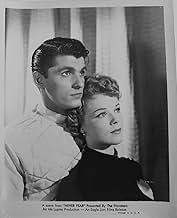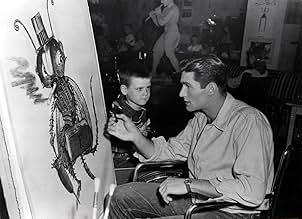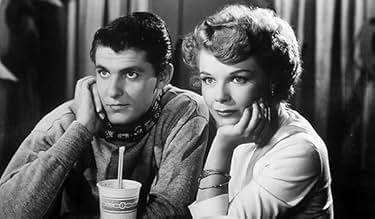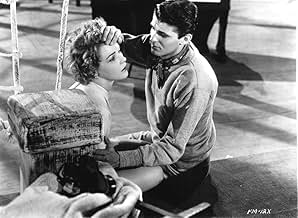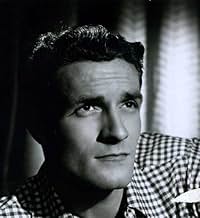IMDb RATING
6.3/10
855
YOUR RATING
A dancer who has just gotten engaged to her partner and choreographer and is about to embark on a major career is devastated to learn that she has contracted polio.A dancer who has just gotten engaged to her partner and choreographer and is about to embark on a major career is devastated to learn that she has contracted polio.A dancer who has just gotten engaged to her partner and choreographer and is about to embark on a major career is devastated to learn that she has contracted polio.
Herb Butterfield
- Walter Williams
- (as Herbert Butterfield)
Jerry Hausner
- Mr. Brownlee
- (as Jerry Housner)
Lulu Mae Bohrman
- Nightclub Patron
- (uncredited)
James Conaty
- Nightclub Patron
- (uncredited)
Herschel Graham
- Nightclub Patron
- (uncredited)
Bert Stevens
- Nightclub Patron
- (uncredited)
Florence Wix
- Nightclub Patron
- (uncredited)
- Director
- Writers
- All cast & crew
- Production, box office & more at IMDbPro
Featured reviews
A little context might be helpful since the scourge of polio has fortunately receded from public view. For those of us post-war kids, polio was a real fear. It struck a lot of youngsters and could not only cripple legs, but also impair breathing and even kill. I can still picture kids sadly confined to iron lungs. Common wisdom among us was to stay away from public pools in the summer. I don't know if this helped, but at least we felt it did. I still remember that day in spring 1955, I believe, when the Salk anti-polio vaccine was announced. It had real impact for us. Anyway, I'm glad folks today don't have to worry, thanks to medical science and The March of Dimes.
The movie itself deals with a young woman's affliction (Forrest) and her various stages of coping. The therapeutic stages are understandably emphasized, along with a generally hopeful resolution that should—for a movie—come as no surprise. Kudoes to Ida Lupino and husband Collier Young for producing a film on what was then (1949) a sensitive subject. (Note how the word 'polio' is hardly used in the screenplay.) The movie's mostly well acted without going over the top. I suspect the romantic angle is played up for greater commercial appeal, along with the alternate title 'Young Lovers'. After all, how many folks would be attracted by a disease themed screenplay. All in all, the human drama of dealing with affliction remains affecting, though the scourge of polio has fortunately receded. In that sense, the film still appeals over and above its time period.
The movie itself deals with a young woman's affliction (Forrest) and her various stages of coping. The therapeutic stages are understandably emphasized, along with a generally hopeful resolution that should—for a movie—come as no surprise. Kudoes to Ida Lupino and husband Collier Young for producing a film on what was then (1949) a sensitive subject. (Note how the word 'polio' is hardly used in the screenplay.) The movie's mostly well acted without going over the top. I suspect the romantic angle is played up for greater commercial appeal, along with the alternate title 'Young Lovers'. After all, how many folks would be attracted by a disease themed screenplay. All in all, the human drama of dealing with affliction remains affecting, though the scourge of polio has fortunately receded. In that sense, the film still appeals over and above its time period.
Carol (Sally Forrest) and Guy (Keefe Brasselle) are an up and coming dance team. However, Carol contracts polio and is now unable to walk. Much of the film is set at a sanitarium that treats paralysis victims and is both about her treatment and adjustment to her new life. Like most people facing this, she goes through severe bouts of depression. It becomes so bad that she pushes Guy out of her life--though he loves her and seems accepting of her disability. Will Carol be able to make a new life for herself or will she give way to defeatism and failure?
This is a pretty unusual film. Despite as many as 58,000 cases of polio in the US (about half of which resulted in paralysis) and a president (FDR) with polio, films act as if the disease never existed. You just don't hear about it in movies for the most part--and "Never Fear" is a rare exception. The only film of the time that reminds me of this is "The Men"--though this is about soldiers who are paralyzed as a result of war wounds. And, both films are quite similar in themes and quality. While "The Men" is a must more prestigious and big-budget movie, director Ida Lupino did a wonderful job in "Never Fear"--providing it with realism that you often don't find in 'disease' films. Very informative and well done all around--with fine acting (by relative unknowns), script and direction--and shot almost documentary style. Well worth seeing.
Finally, let me explain my score of 9. Sure, it's not as pretty a film as many A-pictures. BUT, as a lower-budgeted B, it has a HUGE payoff dollar-for-dollar. You can easily see why Lupino was soon given more chances to direct other B-budget films.
This is a pretty unusual film. Despite as many as 58,000 cases of polio in the US (about half of which resulted in paralysis) and a president (FDR) with polio, films act as if the disease never existed. You just don't hear about it in movies for the most part--and "Never Fear" is a rare exception. The only film of the time that reminds me of this is "The Men"--though this is about soldiers who are paralyzed as a result of war wounds. And, both films are quite similar in themes and quality. While "The Men" is a must more prestigious and big-budget movie, director Ida Lupino did a wonderful job in "Never Fear"--providing it with realism that you often don't find in 'disease' films. Very informative and well done all around--with fine acting (by relative unknowns), script and direction--and shot almost documentary style. Well worth seeing.
Finally, let me explain my score of 9. Sure, it's not as pretty a film as many A-pictures. BUT, as a lower-budgeted B, it has a HUGE payoff dollar-for-dollar. You can easily see why Lupino was soon given more chances to direct other B-budget films.
Ida Lupino's place in Hollywood film history is so unique and unusual that it's no wonder there is a general tendency to overate her output as a director Her moving from actress to director with great control over content was virtually unprecedented.
Although Lupino is not really an especially innovative or important director, (would that she were), she most certainly was a very competent film maker and as such should be remembered.
"The Yound Lovers" of "Never Fear" is a case in point. There is a lot going for this movie. The decidedly B cast of Sally Forest, Keefe Brasselle and Hugh O'Brian are completely convincing and turn in strong performances. This story too, is involving and moving making this all in all \ very watchable.
The problem is Lupino's lack of cinematic style. There's little chance you could spot that this was a Lupino work as you may do with Sirt, Siodamak. Lang, Mann and others of note.
Still, she was an important figure and her movies should be watched.
Although Lupino is not really an especially innovative or important director, (would that she were), she most certainly was a very competent film maker and as such should be remembered.
"The Yound Lovers" of "Never Fear" is a case in point. There is a lot going for this movie. The decidedly B cast of Sally Forest, Keefe Brasselle and Hugh O'Brian are completely convincing and turn in strong performances. This story too, is involving and moving making this all in all \ very watchable.
The problem is Lupino's lack of cinematic style. There's little chance you could spot that this was a Lupino work as you may do with Sirt, Siodamak. Lang, Mann and others of note.
Still, she was an important figure and her movies should be watched.
Carol Williams and Guy Richards are a young dancing couple. They are fighting to climb a tough industry when she falls ill. She has polio. It's a devastating diagnosis as she loses her mobility.
This is written by Ida Lupino and Collier Young. Most importantly, this is one of Ida Lupino's earliest directing credits. As an actress, she was often overshadowed by the stars of her day and she would have been great Hollywood trivia. As a director, she cracked the glass ceiling and did interesting work despite the lower budgets. For this movie, there isn't much to the drama. At least, I'm not interested in the relationship melodrama. I'm more interested in the character growth journey.
This is written by Ida Lupino and Collier Young. Most importantly, this is one of Ida Lupino's earliest directing credits. As an actress, she was often overshadowed by the stars of her day and she would have been great Hollywood trivia. As a director, she cracked the glass ceiling and did interesting work despite the lower budgets. For this movie, there isn't much to the drama. At least, I'm not interested in the relationship melodrama. I'm more interested in the character growth journey.
My grandmother took me to see this film when I was 9 years old.It was at the start of the great polio scare in the U.K.The cinema was the Playhouse in Guildford situated in the Playhouse arcade,an area with rather twee shops(well,it was Guildford in 1950) and a teashop. Of course I wasn't aware that Ida Lupino had directed,co-produced and written "Never fear".For better or worse it was entirely her creature. In the movie business such power was rarely given to women. To my mind that makes her an auteur - or should that be auteuse? The one thing that stands out in my mind from that original viewing 55 years ago is that when polio struck the dancer the camera went out of focus and for years afterwards I thought that losing the focus of your eyes was a sign of the onset of polio.And they say that movies don't influence young children. In fact "never fear" has proved to be a well-made and effective movie in the genre now called rather unkindly "Disease of the Month". It's a very professional job by all concerned and if that sounds as if I am damning it with faint praise it is not the case. Anyone looking for "A woman's touch"(usually meant in a patronising and sexist way)will not find one.It stands up on it's on merits.
Did you know
- TriviaFaire face (1950) was the first directorial credit for actress and pioneering female director Ida Lupino, although an item in The New York Times reported that Frank Cavett was originally intended to direct.
- GoofsA moving shadow of the camera is visible as it pulls back from Carol sitting on the edge of her bed wearing the new nightgown that Guy gave her.
- Crazy credits(opening title card) This is a true story. It was photographed where it happened. Our grateful thanks to the many who made this motion picture possible.
- ConnectionsFeatured in Ida Lupino: Gentlemen & Miss Lupino (2021)
- SoundtracksWhy Pretend
Written by John Franco
Performed by Keefe Brasselle (uncredited)
[Sitting at the piano, Guy sings the song when Carol first becomes ill]
- How long is Never Fear?Powered by Alexa
Details
- Release date
- Country of origin
- Languages
- Also known as
- Je veux vivre
- Filming locations
- Los Angeles County/USC Medical Center - 1200 N. State Street, Los Angeles, California, USA(exterior of "General Hospital")
- Production company
- See more company credits at IMDbPro
Box office
- Budget
- $151,000 (estimated)
- Runtime1 hour 22 minutes
- Color
- Aspect ratio
- 1.37 : 1
Contribute to this page
Suggest an edit or add missing content



